Many birds, fish, mollusks, and other animals went extinct in 2023. However, declaring an animal extinct means that many of these creatures probably ceased to exist on the planet many years ago. There are some repeat figures on this list from 2021 due to the slow process of delisting animals. There are also some new additions, mainly obscure species previously found in specific areas and nowhere else on the planet. Discover the animals that officially went extinct in 2023, including their prior habitat and why they went extinct.
1. Kauaʻi ʻAkialoa
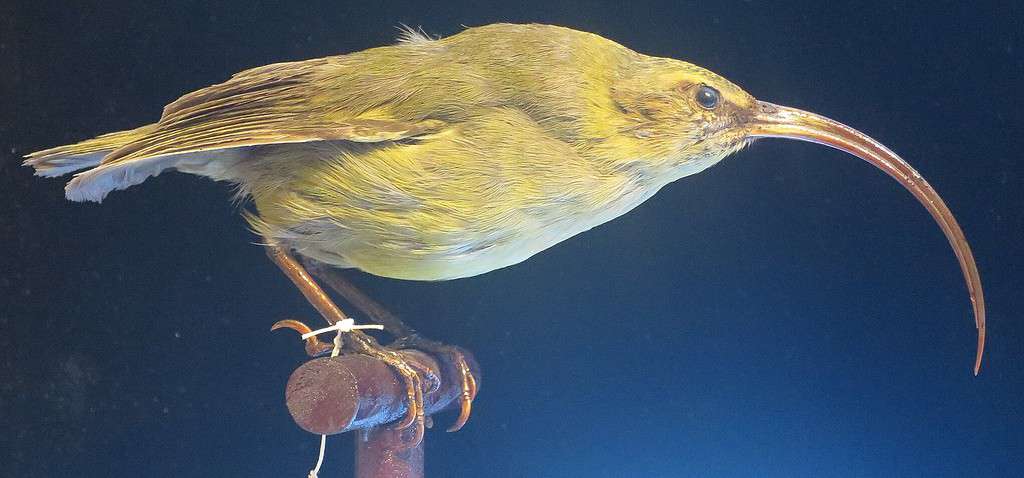
This bird, a species of Hawaiian honeycreeper, was last documented in 1965.
©Hiart / CC0 – License
A tiny bird with a curved bill, the kauaʻi ʻakialoa, or Hemignathus procerus, was olive green and lived on several of the Hawaiian islands. Kauaʻi ʻakialoa hunted arthropods on the ‘ōhi‘a and koa trees. The last known sighting of this honeycreeper species occurred in the Alaka’i Wilderness Preservation. Scientists speculate that the cause of extinction relates heavily to disease and habit loss.
2. Kauaʻi Nukupuʻu
The male and female kauaʻi nukupuʻu, or Hemignathus lucidus hanapepe, had slight sexual dimorphism, with the males mostly yellow and the females mostly dull white. This honeycreeper species was fairly large with a short tail and long, thin bill. The most likely cause of extinction is disease, specifically mosquito-born, but also habitat loss.
3. Kauaʻi ʻŌʻō
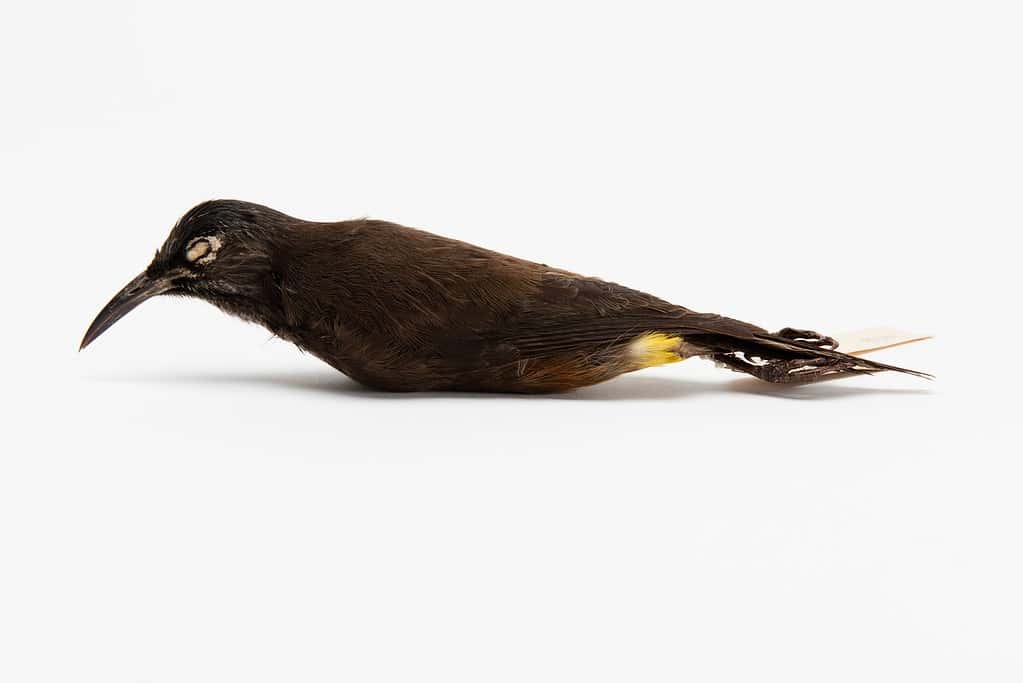
The extinction of the kauaʻi ʻōʻō saw the end of an entire avian family.
©Auckland Museum / CC BY 4.0 – License
This honeyeater species was endemic to Kauai, meaning it occurred on that island exclusively. The Kauaʻi ʻōʻō, or Moho braccatus, was a small bird without the flashy feathers of related species. Although little is known about this animal that officially went extinct in 2023, observers noted that it fed a lot from a flower species that grows in lowland forests. People last sighted the kauaʻi ʻōʻō in the Alaka’i swamp in 1985. Habitat loss and degradation due to hurricanes probably hastened their demise.
4. Kāmaʻo
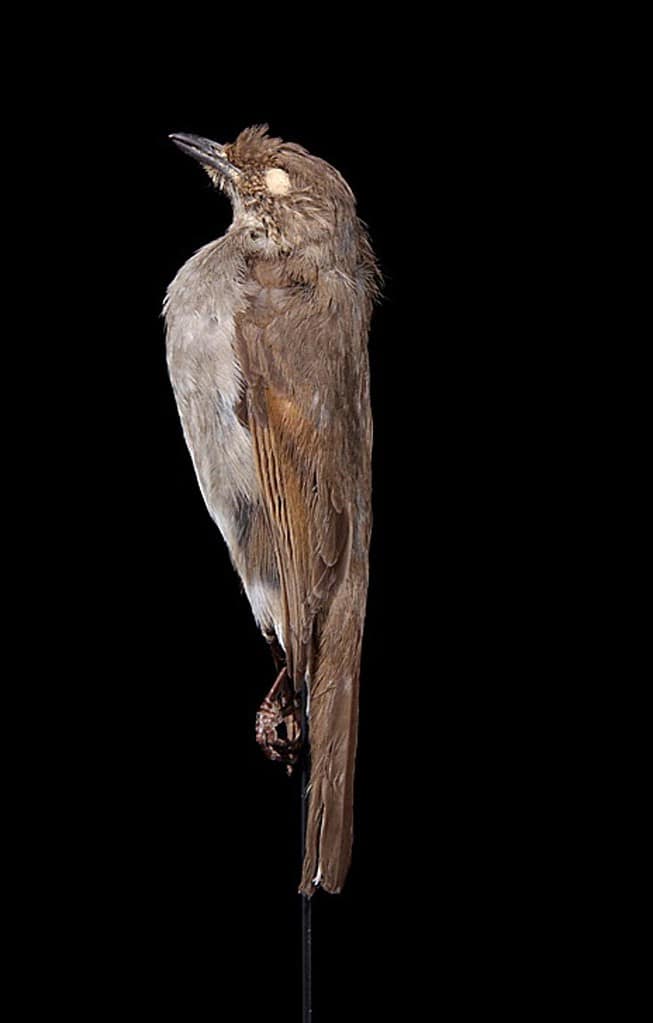
Another name for the kāmaʻo is the large Kauai thrush, and it once was a common sight on the island of Kauai.
©Huub Veldhuijzen van Zanten/Naturalis Biodiversity Center, CC BY-SA 3.0 , via Wikimedia Commons – License
Last seen in 1987, the kāma’o, or Myadestes myadestinus, was one of two solitaire species that inhabited the Kauai island. It had a very beautiful and complex song consisting of warbles, whistles, and trills. Like many other Hawaiian birds that have become extinct, this species most likely died out due to habitat degradation and disease.
5. Maui Ākepa
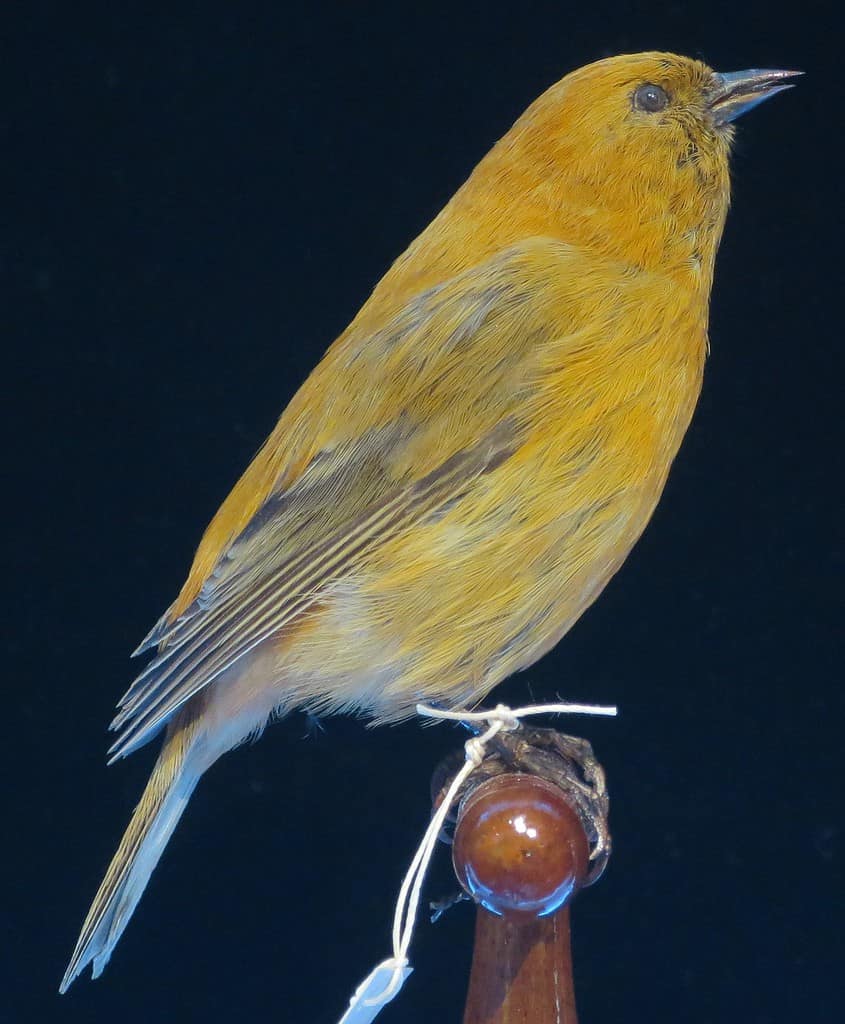
The last sighting of the Maui ‘ākepa occurred on Haleakalā in 1988, the third-largest volcano in Hawaii.
©Hiart / CC0 – License
The petite Maui ‘ākepa, or Loxops coccineus ochraceus, was a species of Hawaiian honeycreeper that survived on insects. It was officially declared extinct in 2023, although the U.S. Fish and Wildlife Service first proposed to delist the species in 2021. Less than 10 years after the last confirmed sighting, someone documented this tiny songbird’s unique call one last time in 1995.
6. Maui Nukupuʻu
Another Hawaiian honeycreeper, the Maui nukupuʻu, or Hemignathus affinis, lived in eastern Maui. It subsisted on ʻōhiʻa lehua and koa trees, which attracted its primary food source. The last confirmed sighting of a Maui nukupuʻu dates back to 1896, with later sightings related to a different bird.
7. Kākāwahie
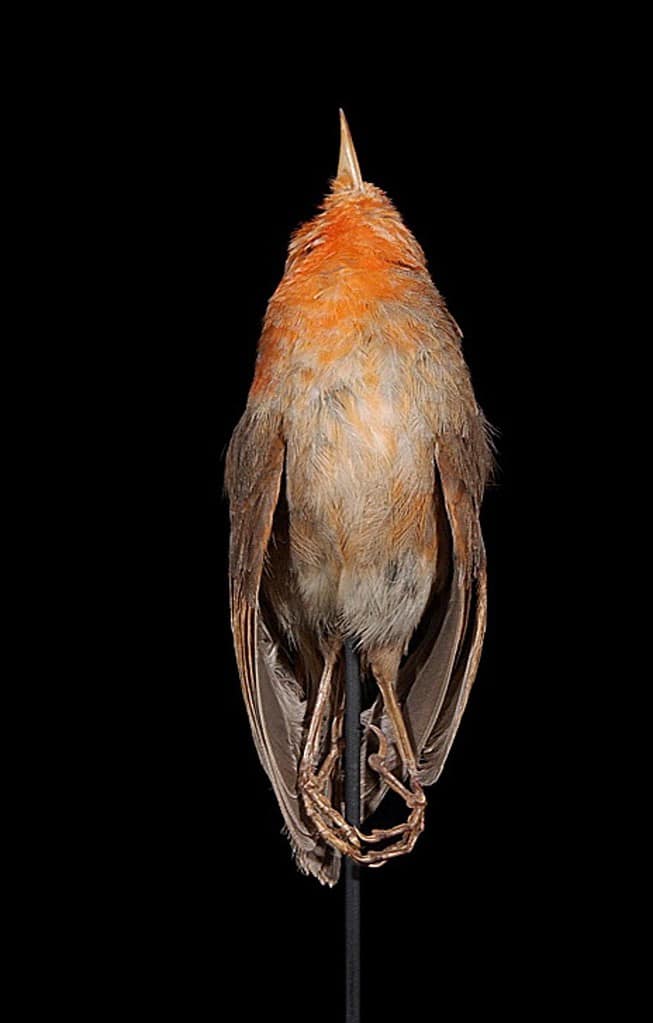
Another name for the kākāwahie is Molokai creeper because it lived only in the forests of eastern Molokai.
©Huub Veldhuijzen van Zanten/Naturalis Biodiversity Center / CC BY-SA 3.0 – License
This Hawaiian honeycreeper featured scarlet red males and rusty females. The kākāwahie, or Paroreomyza flammea, means “firewood” to represent the males’ bright red color. Like many other birds on the Hawaiian islands, this honeycreeper species became extinct due to habitat loss and mammal predation.
8. Poʻouli
The scientific world did not know this honeycreeper species, endemic to Maui, existed until 1973. Declared extinct in 2023, the po’ouli, or Melamprosops phaeosoma, had short wings and tail, a black face mask, and brown wings. Habitat loss due to degradation from feral pigs probably hastened the extinction of this bird. Conservation organizations made attempts to save this animal from extinction, but the last three birds in captivity died in 2004.
9. Bachman’s Warbler
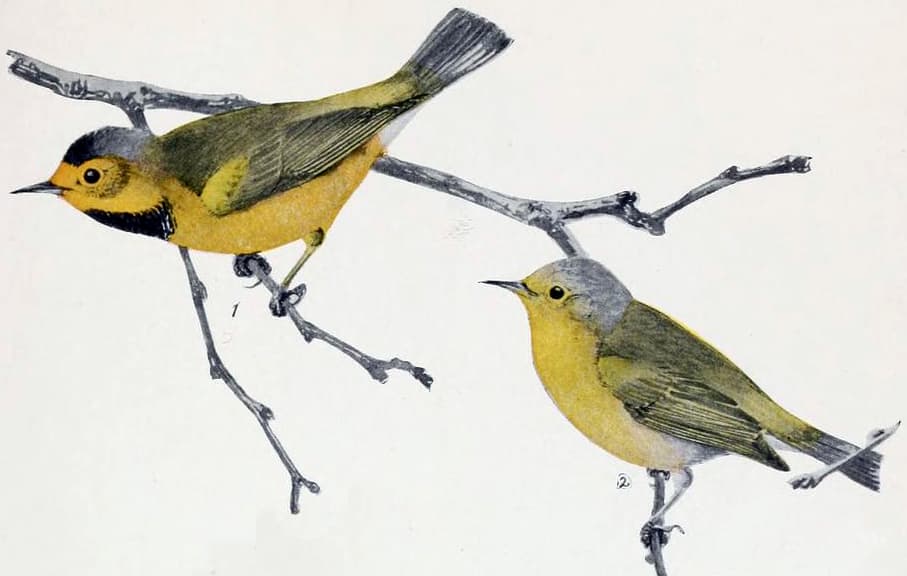
Historically, the Bachman’s warbler lived in bottomland forests and swamps in Alabama, Arkansas, Missouri, Kentucky, and South Carolina. They spent winters in Florida and Cuba.
©907 × 576 pixels, file size: 260 KB, MIME type: image/jpeg – License
A rare songbird, the Bachman’s warbler, or Vermivora bachmanii, primarily ate insects. Very few sightings made it challenging to document the behavior of this bird. It also made it hard to determine threats, although collisions with tall buildings were likely one of them.
10. Bridled White-Eye

Other subspecies of bridled white-eye birds live in the Mariana Islands.
©Editor abcdef / CC0 – License
A native subspecies on Guam, the bridled white-eye, or Zosterops conspicillatus conspicillatus, was a small bird. It lived in the forests of Guam and was last sighed in 1983. The introduction of the brown tree snake to the island led to a rapid decline of the bridled white-eye.
11. Little Mariana Fruit Bat

This tropical bat species likely declined due to habitat loss due to military activity and agriculture.
©Jon Irvine / CC BY-SA 2.0 – License
A small fruit bat, the little Mariana fruit bat, or Pteropus tokudae, had a tiny wingspan less than 30 inches in length. With the name Guam flying fox, this rare bat ate fruit and flowers in northern Guam. Predation by a nonnative snake species probably worsened the conservation of the little Mariana fruit bat.
12. San Marcos Gambusia
A tiny fish at only one inch long, the San Marcos gambusia, or Gambusia georgei, could be identified by a dark stripe on the edge of its dorsal fin. Before officially declared extinct in 2023, this fish species lived only in the San Marcos River in Hays County, Texas. Extinction resulted from reduced water flow from clear springs and extensive pollution from neighboring cities.
13. Scioto Madtom
The Scioto madtom, or Noturus trautmani, was a nocturnal catfish found in a tributary of the Scioto River. The extinction of this catfish likely resulted from pollution from industrial and agricultural sources and silt accumulation from dams. It hid under rocks during the daytime and came out at night to forage at the bottom of the creek. Ohio added the Scioto madtom to a list of endangered species in 1974, but conservation efforts could not save it.
14. Pointed Plateau Loach
A type of stone loach, the pointed plateau loach, or Triplophysa cuneicephala, could only be found near Beijing, China. This fish was related to other stone loaches, which survive in high altitudes in cold water. Habitat loss led to the extinction of this fish, as the Chinese government transformed streams into large reservoirs.
15. Java Stingaree
The Java stingaree, or Urolophus javanicus, was about the size of a frisbee. Only one specimen was ever collected back in 1862, and no others have ever been found in fish markets or the wild. Extensive habitat degradation in the area of Jakarta Bay is linked to the extinction of this fish.
16. Campo Grande Tree Frog
The elusive Campo Grande tree frog, or Boana cymbalum, has only ever been documented in one spot on earth and was recently declared extinct by the IUCN. Scientists noted it as a distinct species in Campo Grande da Serra in Brazil. Threats to its survival were development, invasive species, and pollution.
17. Cheongpung Blind-Beetle
The Cheongpung blind-beetle, or Coreoblemus parvicollis, was officially declared extinct in 2023 by the IUCN. This beetle lived in total darkness in the Cheongpungpunghyeol Cave, which sits near the Hankang River in South Korea. The most likely cause of extinction was habitat destruction after the cave flooded after the creation of the largest dam in South Korea.
Several Species of Freshwater Mussels:
18. Green-Blossom Pearly Mussel
19. Flat Pigtoe
20. Southern Acornshell
21. Stirrupshell
22. Tubercled-Blossom Pearly Mussel
23. Turgid-Blossom Pearly Mussel
24. Upland Combshell
25. Yellow-Blossom Pearly Mussel
Summary of # Animals That Went Extinct in 2023
| Rank | Name | Last Seen |
|---|---|---|
| #1 | Kauaʻi ʻakialoa | 1965 |
| #2 | Kauaʻi nukupuʻu | 1899 |
| #3 | Kauaʻi ʻōʻō | 1985 |
| #4 | Kāmaʻo | 1987 |
| #5 | Maui ākepa | 1988 |
| #6 | Maui nukupuʻu | 1896 |
| #7 | Kākāwahie | 1963 |
| #8 | Poʻouli | 1997 |
| #9 | Bachman’s Warbler | 1988 |
| #10 | Bridled White-Eye | 1983 |
| #11 | Little Mariana Fruit Bat | 1967 |
| #12 | San Marcos Gambusia | 1983 |
| #13 | Scioto Madtom | 1957 |
| #14 | Pointed Plateau Loach | 1950s |
| #15 | Java Stingaree | 1862 |
| #16 | Campo Grande Tree Frog | Unknown |
| #17 | Cheongpung Blind-Beetle | Unknown |
| #18 | Green-Blossom Pearly Mussel | 1980s |
| #19 | Flat Pigtoe | 1980 |
| #20 | Southern Acornshell | 1973 |
| #21 | Stirrupshell | 1987 |
| #22 | Tubercled-Blossom Pearly Mussel | 1969 |
| #23 | Turgid-Blossom Pearly Mussel | 1965 |
| #24 | Upland Combshell | 1988 |
| #25 | Yellow-Blossom Pearly Mussel | 1967 |
The photo featured at the top of this post is © Hiart / CC0 – License / Original
Thank you for reading! Have some feedback for us? Contact the AZ Animals editorial team.







